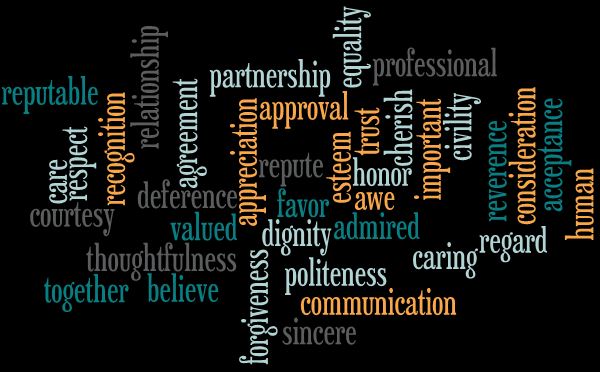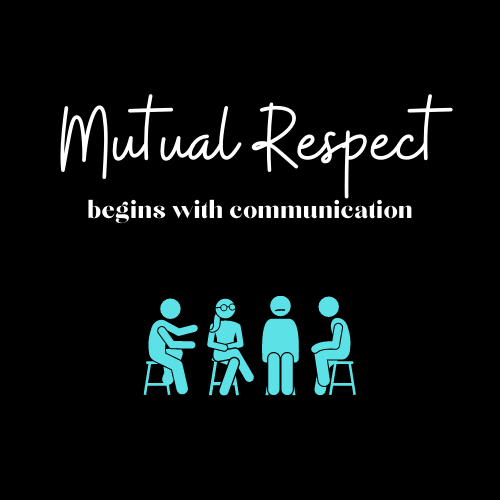
Defining the meaning of respect is challenging. Defining the meaning of mutual respect is even more difficult. The main reason for this struggle is that the word respect is both a noun and a verb. When you Google “definition of respect” three different definitions come up for respect as a noun and one for respect as a verb. When a word or concept has so many different definitions it can be very hard to come to common ground when using it in conversation. For the purposes of this article, I will be using the definition of respect from Immanuel Kant, as quoted in Dillon (2018): “the acknowledgment in attitude and conduct of the dignity of persons as ends in themselves.” To put this in modern terms, people deserve respect and dignity because they are people; this removes the saying “respect is earned.” I believe that the saying should be “respect is given.” Defining mutual respect is just as challenging. The definition of mutual respect that I will be using is that mutual respect requires citizens to be reasonable, inclusive, tolerant and to be willing to compromise rather than to dogmatically defend one’s position without consideration for others (Bird, 2010).
Respect and respectful interactions online are covered under the International Society for Technology in Education (ISTE) digital citizenship advocate standard 7b: “Partner with educators, leaders, students and families to foster a culture of respectful online interactions and a healthy balance in their use of technology” (n.d.). The questions that I will explore in this article are: how are we teaching students to be respectful online? Are we working with students to define terms like respect?
When thinking about respect in an online environment, it is important to recognize how anonymity can impact behavior. We currently live in an era where there are too many “keyboard warriors”. A “keyboard warrior” is someone “who posts highly opinionated text and images online in an aggressive or abusive manner, often without revealing his or her identity,” these people are sometimes referred to as “trolls” (Dictionary.com, n.d.). Additionally a study on respect and mutual respect by Maia and Rezende showed that there was a statistically significant connection between the use of foul language and anonymity in online environments (2016). How then, in this environment can schools and families teach students about the importance of respect and mutual respect?
In the school district where I work, and in schools across the globe, educators are actively working to implement restorative practices. Using restorative practices as a whole school proactive approach to behavior is one way that many schools are starting to actively teach and foster respect. According to Kehoe et al. (2018) schools that focus on restorative practices are more likely to use a whole community approach to include students, teachers, and families. Additionally, students self-reported that when they saw their teachers treating others with respect, they could see the value in behaving similarly. The study by Kehoe et al. (2018) found that students who attended a restorative practices school were able to build relationships, take responsibility for their behaviors and develop empathy for others. This approach to restorative practices does not just impact the students in the school, it impacts the entire community. This is one method for teaching students how to have respectful interactions with others. As Oliver (2020) points out, we often do not know how someone wants to be respected until we ask them. The skills learned in the classroom are likely to transfer to the technology world if used in wholistic approach, incorporating restorative practices, digital citizenship classes, and teacher/parent modeling.
Another initiative that is being implemented in the state of Washington is mandatory Social Emotional Learning education. According to the “Social Emotional Learning Pathways” by the Washington Office of Superintendent of Public Instruction (OSPI) (2019), teaching the concept of respect in the school system begins as early as preschool. OSPI does not mandate the type of curriculum that should be used in schools, however, it does require that the curriculum cover the SEL Standards as they have established. One such curriculum that my district is utilizing is Character Strong. Character Strong (n.d.) defines respect as: “treating others as if they were important (because they are!), valuing people for their humanity, even though they might be different than you.” When families and educators partner together to teach SEL skills, these skills are far more likely to take root.
Teaching respect is not as easy as it sounds. While many teachers have the rule “be respectful” up on their classroom wall, they often fail to define what that term means to them (Oliver, 2020). This is one thing that restorative practices and respect agreements works to remedy. Students and educators work together to come to mutually agreed upon definitions and examples of what respect looks like. This makes it easier for everyone to hold each other accountable. Lessons on respect, whether done using digital technology or through more traditional means, meet the requirements of the Triple E Framework. Respect engages students in learning goals, enhances learning goals and extends learning goals; when a respectful environment does not exist, learning and teaching become challenging (Kolb, n.d.).
Teaching respect is not something that schools should be solely responsible for, parents and community members need to partner with educators. In 2012 Cassidy et al., interviewed parents on how to prevent cyber bullying and foster cyber kindness; parents stated that it was their responsibility to teach empathy and respect. Parents in the study also stated that two of the best ways to teach respect to their students was through modeling and practice (Cassidy et al., 2012). The concept of modeling and practice ties right back to restorative practices, which rely heavily on teacher modeling and practice. Additionally, modeling and practice are the cornerstone in any sound educational pedagogy. Secondary to modeling and practice is taking responsibility for breaking respect expectations. This can be done with parents through conversation and loss of privileges, or it can be done at school through restorative circles where anyone who breaks a respect agreement is asked to take responsibility for their actions and to make amends (Bradford & Lesal, 2021).
What about when it is adults behaving disrespectfully? Williams (2018) points out that when children are treated disrespectfully online words like “cyberbullying” and “harassment” are used. As stated earlier, Cassidy et al. (2012) noted that parents said they needed to model respectful online behavior. Children are like sponges, they see everything that the adults in their lives are doing, yet when adults behave badly online the current reaction is to turn a blind eye, or worse cheer on the backlash (Williams, 2018). If we truly want to teach our students to have respectful interactions online, the adults in their lives will need to start modeling that behavior and holding each other accountable when that standard is violated (ISTE, n.d.). Utilizing SEL curriculum and restorative practices in schools are two of the many ways that schools and digital education leaders can teach respect in schools, but parents and families also need to partner with educators so children can see all the adults in their lives modeling respect and mutual respect.

References
Bird, C. (2010). Mutual Respect and Civic Education. Educational Philosophy and Theory, 42(1), 112-128. https://doi.org/10.1111/j.1469-5812.2008.00508.x
Bradford, N., & Lesal, D. (2021). A real-world guide to restorative justice in schools: Practical philosophy, useful tools, and true stories. Jessica Kingsley Publishers.
Cassidy, W., Brown, K., & Jackson, M. (2012). “Making Kind Cool”: Parents’ suggestions for preventing cyber bullying and fostering cyber kindness. Journal of Educational Computing Research, 46(4) 415-436. https://doi.org/10.2190%2FEC.46.4.f
Character Strong. (n.d.). Respect. Character Strong. Retrieved November 12, 2021, from https://curriculum.characterstrong.com/wp-content/uploads/curriculum_audit_uploads/posters/images/CharacterStrong%20-%20Respect.jpg
Dictionary.com. (n.d.). Keyboard warrior. In Dictionary.com dictionary. Retrieved November 13, 2021, from https://www.dictionary.com/browse/keyboard-warrior
Dillon, R. (2018). Respect. Stanford Encyclopedia of Philosophy. Retrieved November 12, 2021, from https://plato.stanford.edu/entries/respect/
International Society for Technology in Education. (n.d.). ISTE standards for coaches. International Society for Technology in Education. Retrieved November 6, 2021, from https://www.iste.org/standards/for-coaches
Kehoe, M., Bourke-Taylor, H., & Broderick, D. (2018). Developing student social skills using restorative practices: A new framework called H.E.A.R.T. Social Psychology of Education, 21, 189-207. https://doi.org/10.1007/s11218-017-9402-1
Kolb, L. (n.d.). Triple E Framework. Triple E Framework. Retrieved November 12, 2012, from https://www.tripleeframework.com/
Maia, R., & Rezende, T. (2016). Respect and disrespect in deliberation across the networked media environment: Examining multiple paths of political talk. Journal of Computer-Mediated Communication, 21(2016), 121-139. https://doi.org/10.1111/jcc4.12155
Oliver, K. (2020). Restorative practices: How to a respect agreement cheat sheet. Leaving the Village LLC.
Washington Office of Superintendent of Public Instruction. (2019). Social emotional learning pathways. Washington Office of Superintendent of Public Instruction. https://www.k12.wa.us/sites/default/files/public/OSPI-SEL-Pathways.pdf Williams, J. (2018). Stand out of our light: Freedom and resistance in that attention economy. Cambridge University Press. https://doi.org/10.1017/9781108453004
